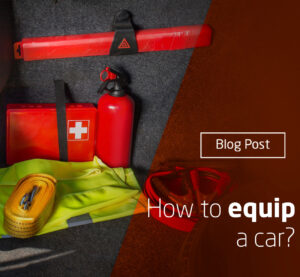
Failure – an inevitable feature of any vehicle
No car is reliable. Although car manufacturers often argue about the reliability of their product, every rational owner of a vehicle is aware that sooner or later he will have to face some minor or major defect. It is important to be able to diagnose the problem quickly and to know how to deal with it. Below is a list of the five most common car breakdowns.
1. Brakes failure
The first of the most common car breakdowns is brake failure. This is a serious threat to the driver and passengers. Damaged or corroded brake hoses are often the cause of brake failure. This is why it is extremely important to monitor the brake fluid level. When there is not enough fluid, it could be a sign of leakage. Brake failure can also be the result of worn brake pads. This fault is especially dangerous when the vehicle hits a large hole in the road. Then the brake pads may even come off the calipers! Another cause of the failure is the boiling of the brake fluid. The boiling of the brake fluid usually occurs after prolonged braking – for example, when the driver is going downhill for a long time. In such situations, it is worth relieving the brake system and breaking the engine. Engine braking is a process of shifting down a gear and making sure that the engine is running at high speed. This action has two benefits – brake pad wear is lower and fuel consumption is zero. Note that brake failures are extremely dangerous. When we are unable to deal with them ourselves, you should go to the car service as soon as possible.
2. Electrical system failure
The second malfunction that often happens to drivers on the road is the failure of the electrical system. There are many reasons for this type of failure. These can be, for example, a short circuit in the installation, a blown fuse, discharge of an overloaded battery, a factory defect – which, contrary to appearances, is not rare. Taking care of the battery eliminates failures of the electrical system. However, some batteries need to be replaced after a short time. It happens that a newly replaced battery – to the surprise of the vehicle owner – only lasts three or four years. Of course, there are also electrical system failures unrelated to battery operation, but they are quite difficult to predict. Such failures can be caused by the poor condition of the integrated circuits, the presence of short circuits in the tangle of wires under the dashboard, and several other factors. Electrical system failures are generally not as dangerous as brake failures. This does not change the fact that the lack of the ability to diagnose or deal with them should be a reason to visit a car mechanic.
3. Engine failure
The third common car failure is engine failure. Here – as in the above cases – there can be many reasons. Typical include: scuffing of the timing belt, broken timing belt, and turbine failure. There is one way that minimizes the risk of broadly defined engine failures. It is taking care of the engine oil, and more precisely – its regular replacement and monitoring its proper level. Caring for engine oil is extremely important when the engine is modern and has a turbocharger. Besides, engine failures, quite surprisingly, are more common in innovative vehicles. Owners of this type of vehicle often face turbine faults. The appearance of such a defect is usually preceded by a noticeable decrease in engine power, greater smoke in the exhaust gases, and louder operation of the turbine. If also, there are noticeable oil leaks from the vicinity of the turbine and drops in the oil level, it means that the vehicle should be immediately delivered to a car service.
4. Clutch malfunctions
The fourth failure that often happens to vehicle users is a clutch failure. A car is more prone to clutch faults the more it is used in so-called urban conditions. In theory, the clutch should be operational after traveling tens of thousands of kilometers. In practice, however, such activities as frequent starting, performing maneuvers on the half-clutch, climbing up, dynamic movement from one light to another can shorten the efficiency of the clutch by up to half. Clutch failure is dangerous. If the driver only notices that there is something wrong with the clutch, he should immediately call for assistance (see more below) or go to the nearest car garage.
5. A flat or damaged tire
The fifth failure, probably the most frequent failure for drivers while traveling by car, is a flat or damaged tire. The tire cannot be protected against a puncture. It does not change the fact that you should be prepared for such an eventuality. This preparation consists primarily of monitoring the condition of the spare wheel and the pressure level in this wheel. In addition, the permanent equipment of the car should include a jack and a wheel wrench. Tire inflation repair kits are a more modern solution, which is becoming more and more popular with drivers. The Aircom repair kit is such a reputable and valued set by many vehicle brands. It consists of a tire compressor and a sealant. The Aircom tire inflation repair kit guarantees continued to travel up to 200 kilometers and speeds of up to 80 kilometers per hour. It also has many other advantages, such as simple operation, small size, lightweight, high efficiency, long life, eco-friendliness, and others. However, in the event of a tire defect, i.e. a puncture or damage to the tire, and not having a repair kit, it is worth using assistance – it is additional protection, often added to Auto Casco insurance, which can also be used by holders of some credit cards (more on this below).
Purchase of an assistance policy
As already mentioned, car breakdowns are inevitable. It is worth remembering about this and protecting yourself against the appearance of a fault. A good solution is to take out the aforementioned assistance policy. An assistance policy is a voluntary insurance policy that provides the insured person with a specific type of assistance. It can be, for example, information, service, or medical assistance. The basic areas of life covered by the assistance policy are road transport (which in the context of this article interests us the most), travel, home, family, health. The scope of this insurance cannot be specified as it is dependent on the respective insurance company. The exact scope of the policy is provided in the document “General insurance conditions”.
The impact of the assistance policy on the discounts under third party liability and motor insurance
Warto dodać, że wykupienie polisy assistance i skorzystanie z niej nie wpływa na zniżki za bezszkodową jazdę w ramach ubezpieczenia OC (ubezpieczenie odpowiedzialności cywilnej) oraz ubezpieczenia AC (dobrowolne ubezpieczenie pojazdów mechanicznych). Mało tego, niektóre pakiety Auto Casco zawierają już polisę assistance. W związku z tym kierowca w razie potrzeby ma zapewnione holowanie auta do określonej liczby kilometrów.
Checking the car, or how to check it yourself
Carrying out professional and independent inspections may cause the driver to detect a failure and deal with it inconvenient conditions – it is primarily about time and place. Each vehicle must undergo a technical inspection at a vehicle inspection station once a year (less frequently every two or three years). During them, the following elements are primarily checked:
- engine oil,
- operating fluids such as coolant, washer fluid, brake fluid, power steering fluid,
- brake condition,
- state of suspension,
- suspension geometry,
- steering system,
- electrical system,
- battery,
- lighting.
It is the responsibility of every driver to keep these inspections scheduled. In addition, it is worth doing your inspections – especially before a long journey. What can you check yourself? Below is a list of things that each driver should check:
- engine oil,
- operating fluids,
- tire pressure,
- wipers,
- car lighting (set of light bulbs).
Equipping the car, i.e. what elements to carry in the car
Appropriate equipment of the car can help to deal with a breakdown quickly and independently or at least ensure the safety of the driver and passengers during an unwanted stop on the road. And so the elements that must be fitted to the vehicle are:
- fire extinguisher,
- warning triangle.
In addition, (although it is not mandatory, i.e. regulated by law), it is also worth getting items such as:
- vest,
- tow rope,
- a flashlight,
- first aid kit,
- tire inflating repair kit (for example the mentioned Aircom tire inflating repair kit),
- other essential tools.
Car breakdowns and protection against them – summary
Car breakdowns are inevitable. The typical ones include the above-mentioned: brake failure, electrical system failure, engine failure, clutch failure, and a flat or damaged tire. Of course, these are not the only faults faced by drivers. There are many more of these faults. They mainly depend on the vehicle brand, age, and operation. Despite the fact that every driver will sooner or later encounter problems with the car, it is worth protecting yourself against these problems. And such a good idea is to take out an assistance policy that does not affect the discounts under third party liability and motor insurance. In addition, it is a good idea to check the condition of the vehicle from time to time – especially before long journeys. The last element that helps in dealing with breakdowns is the appropriate equipment of the car. All this will certainly save the driver’s time, reduce stress, and allow for planned – safe and quick reaching of the goals.





